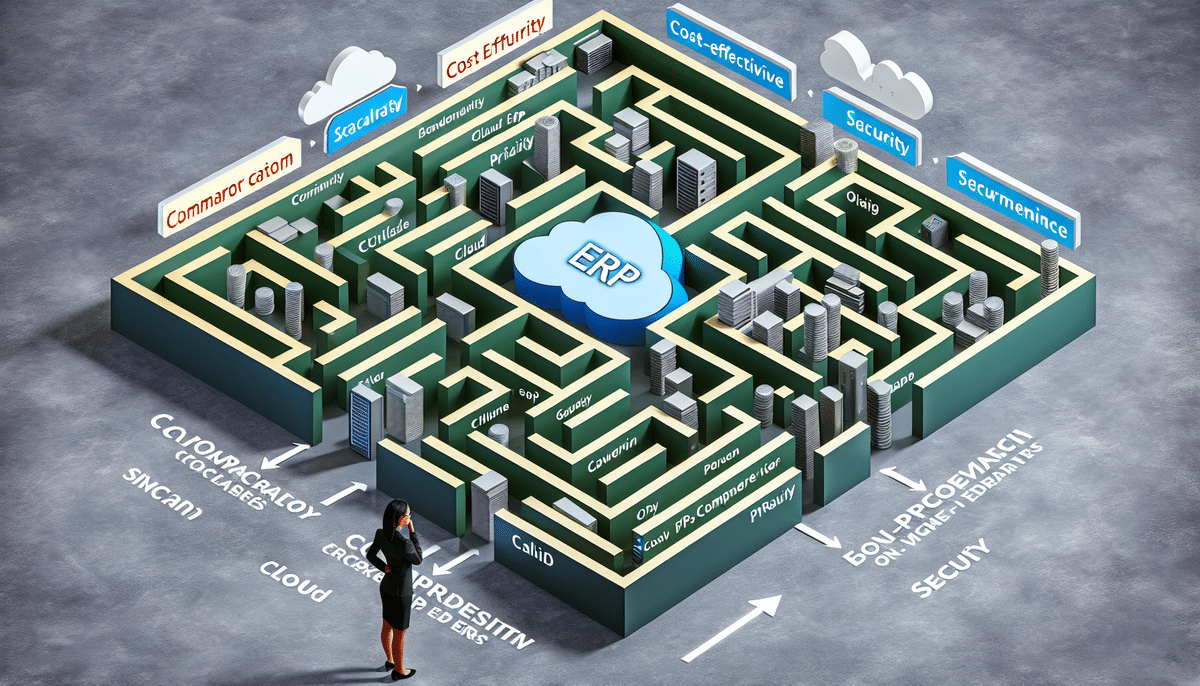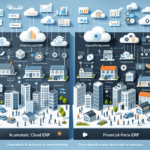Introduction to ERP Systems
In the rapidly evolving business landscape, Enterprise Resource Planning (ERP) systems are essential for organizations aiming to streamline operations, manage finances, and enhance productivity. According to Gartner, the global ERP software market is projected to reach $49 billion by 2027, underscoring its critical role in business strategy.
Choosing the right ERP solution can be daunting given the plethora of options available. This article provides an in-depth comparison between two leading ERP solutions: Acumatica Cloud ERP and Priority ERP. By examining their features, pricing, implementation processes, and more, this guide aims to help you make an informed decision tailored to your business needs.
Overview of Acumatica Cloud ERP
Acumatica Cloud ERP is a robust, scalable cloud-based ERP solution designed for small to mid-sized businesses. It offers a comprehensive suite of features that cater to various business functions, including:
- Financial Management
- Distribution Management
- Project Accounting
- Customer Management
- Supply Chain Management
- And more
One of Acumatica's standout features is its flexible pricing model, allowing businesses to pay only for the modules they need and easily scale as they grow. This modular approach ensures that companies can customize their ERP system to match their specific operational requirements.
Mobile Accessibility is another key advantage of Acumatica. With its mobile app, users can access critical business data and perform essential tasks from anywhere, enhancing flexibility and productivity. According to a report by Business Wire, mobile accessibility can increase employee productivity by up to 30%.
Additionally, Acumatica boasts advanced reporting and analytics capabilities. Businesses can generate custom reports and dashboards to gain actionable insights, facilitating data-driven decision-making. Integration with popular business intelligence tools like Microsoft Power BI further enhances its analytics prowess.
Overview of Priority ERP
Priority ERP is a comprehensive ERP solution catering to small and mid-sized enterprises. It offers a wide array of features, including:
- Financial Management
- Manufacturing Management
- Sales and Customer Management
- Supply Chain Management
- Human Resources
- And more
Priority ERP provides both cloud-based and On-Premises deployment options, offering flexibility to businesses based on their infrastructure preferences and data security needs. Its user-friendly interface and advanced automation capabilities are designed to enhance operational efficiency.
The system's advanced analytics and reporting tools enable businesses to extract valuable insights from their data. With customizable reports and seamless integration with other business applications like CRM and e-commerce platforms, Priority ERP helps organizations streamline their operations and improve overall efficiency.
Comparative Analysis
Key Differences Between Acumatica Cloud ERP and Priority ERP
When selecting between Acumatica Cloud ERP and Priority ERP, it's essential to consider the following key differences:
- Deployment Options: Acumatica is exclusively a cloud-based solution, offering scalability and ease of access. In contrast, Priority provides both cloud-based and On-Premises deployment options, catering to businesses with specific compliance or control requirements.
- Pricing Model: Acumatica's flexible pricing allows customers to pay only for the modules they need, enhancing customization and integration flexibility. Priority employs a more traditional pricing model based on the number of concurrent users, which can be more cost-effective for larger teams.
- User Interface: Acumatica features a modern, intuitive interface that facilitates ease of use and quick navigation. Priority's interface is more traditional, which might require additional training for users to achieve proficiency.
- Mobile Accessibility: Acumatica offers a robust mobile app, enabling users to access the ERP system on the go. Priority currently does not provide a dedicated mobile application, potentially limiting remote access capabilities.
Pricing and Cost Comparison
Understanding the pricing structures of both ERP solutions is crucial for budgeting and financial planning:
- Acumatica: Offers a modular pricing model starting at approximately $5,000 per year for five users. The cost increases based on the number of users and modules selected, providing flexibility for growing businesses.
- Priority: Utilizes a traditional pricing model starting at around $10,000 per year for ten concurrent users. This model can be more advantageous for larger organizations with a higher number of users.
Additionally, Acumatica offers various support packages at extra costs, whereas Priority includes a higher level of support and maintenance within their standard pricing, which may benefit businesses requiring extensive technical assistance.
Implementation and Deployment
The implementation process varies between Acumatica and Priority ERP:
- Acumatica: Being cloud-based, Acumatica's deployment is typically quicker and more straightforward, allowing businesses to go live faster. The cloud infrastructure reduces the need for significant upfront investments in hardware.
- Priority: Offers both cloud and On-Premises deployment. While the cloud deployment is relatively swift, the On-Premises option may require a longer implementation period due to the need for hardware setup and more extensive customization.
It's important for organizations with limited internet connectivity or stringent data security requirements to consider Priority's On-Premises deployment, which offers greater control over data and system configurations.
User Experience and Interface
User experience plays a pivotal role in ERP adoption and efficiency:
- Acumatica: Features a modern, user-friendly interface that enhances navigation and usability. The high level of customization allows users to tailor the dashboard and workflows to their specific needs.
- Priority: While the interface is functional, it has a more traditional design that might not be as intuitive as Acumatica's. However, it remains user-friendly and offers various options for personalizing the user experience.
According to a study by NNG Group, a user-friendly ERP interface can increase user adoption rates by up to 25%, highlighting the importance of intuitive design in ERP systems.
Customization and Flexibility
Customization and flexibility are critical for tailoring the ERP system to organizational needs:
- Acumatica: Offers extensive customization options, allowing businesses to modify modules and integrate with various third-party applications through its open API. This flexibility supports unique business processes and scalability as the organization grows.
- Priority: Provides a comprehensive solution with significant customization capabilities, though it may be less flexible compared to Acumatica in terms of integrating with diverse systems. Priority's customization is designed to accommodate complex workflows within its ecosystem.
However, Acumatica's high level of customization may require more technical expertise, whereas Priority's customization options are more accessible to non-technical users.
Integration Capabilities
Seamless integration with other systems is essential for maximizing ERP functionality:
- Acumatica: Excels in integration capabilities with its open architecture, allowing easy connection with numerous third-party systems, including CRM, e-commerce platforms, and custom-built applications. This ensures that businesses can maintain cohesive operations across various departments.
- Priority: Offers a wide range of integrations, including compatibility with applications like Microsoft Office and SAP Business One. While robust, its integration flexibility is somewhat more limited compared to Acumatica's open API.
A report by Software Advice emphasizes that effective ERP integration can improve data accuracy by 25% and reduce operational redundancies, highlighting the significance of strong integration capabilities in ERP systems.
Reporting and Analytics
Advanced reporting and analytics are vital for informed decision-making:
- Acumatica: Offers real-time data analysis with interactive dashboards and comprehensive reporting tools. Its integration with Microsoft Power BI enables sophisticated data visualization and deeper insights into business performance.
- Priority: Provides extensive reporting features with a wide range of customizable reports. While effective, its data visualization tools are more basic compared to Acumatica's advanced options.
Acumatica's ability to handle large data volumes efficiently makes it ideal for businesses with complex reporting needs, whereas Priority maintains solid performance but may experience slower processing with exceptionally large datasets.
Security and Data Privacy
Data security and privacy are paramount in ERP systems:
- Acumatica: Being cloud-based, Acumatica ensures robust security measures, including data encryption, regular backups, and disaster recovery protocols. Cloud hosting providers typically adhere to stringent security standards, offering peace of mind to businesses.
- Priority: Offers greater control over data security, especially with its On-Premises deployment option. This is particularly beneficial for industries with strict compliance and data privacy regulations, allowing businesses to implement tailored security measures.
According to CSO Online, over 60% of organizations prioritize data security when selecting an ERP system, making it a critical factor in the decision-making process.
Customer Support
Reliable customer support is essential for maximizing ERP system effectiveness:
- Acumatica: Provides 24/7 customer support with a responsive and knowledgeable team. Additionally, Acumatica offers extensive online resources, including documentation, training materials, and a community forum.
- Priority: Offers dependable support services, including technical assistance and regular updates. However, response times may vary based on the customer base size and support tier selected.
Effective customer support can significantly reduce downtime and enhance user satisfaction, as highlighted by a study from Zendesk, which found that 70% of businesses value responsive support highly when dealing with ERP issues.
Conclusion and Recommendations
Choosing between Acumatica Cloud ERP and Priority ERP hinges on your organization's specific needs, budget, and long-term goals. If your business prioritizes flexibility, scalability, and advanced mobile and integration capabilities, Acumatica Cloud ERP is a compelling choice. Its modern interface and robust reporting tools make it ideal for companies seeking a highly customizable and mobile-accessible solution.
Conversely, if your organization requires greater control over data security, prefers an On-Premises deployment, and benefits from a more traditional pricing model with comprehensive support included, Priority ERP may be the better fit. Its user-friendly customization options and reliable support services cater well to businesses with specific compliance and operational requirements.
Ultimately, conducting a thorough assessment of your business processes, budget constraints, and future growth plans is essential. Consider leveraging free trials or demos offered by both ERP providers to gain hands-on experience and ensure the selected system aligns seamlessly with your organizational objectives.
Final Thoughts and Recommendations
Selecting the right ERP system is a pivotal decision that can significantly impact your organization's efficiency and growth trajectory. When evaluating Acumatica Cloud ERP and Priority ERP, consider the following recommendations:
- Assess Your Needs: Clearly define your business requirements, including necessary features, scalability, and integration needs.
- Evaluate Total Cost of Ownership: Consider not only the initial costs but also ongoing expenses related to maintenance, support, and potential upgrades.
- Consider User Experience: Prioritize systems with intuitive interfaces and robust training resources to facilitate user adoption.
- Examine Security Measures: Ensure the ERP solution meets your data security and compliance standards.
- Leverage Demos and Trials: Utilize free trials or demonstrations to experience the ERP systems firsthand and assess their compatibility with your business processes.
- Seek Expert Consultation: Engage with ERP consultants or industry experts to gain insights and recommendations tailored to your specific needs.
By carefully evaluating these factors, you can select an ERP system that not only meets your current operational needs but also supports your organization's growth and strategic objectives in the long term.




















